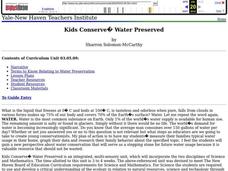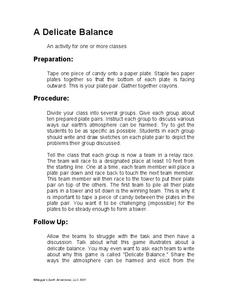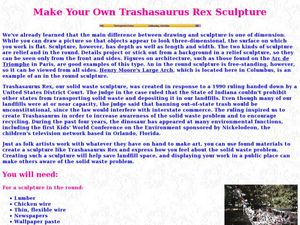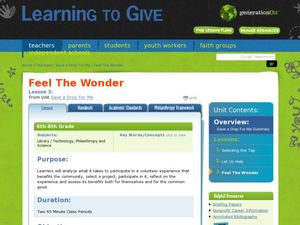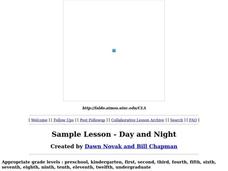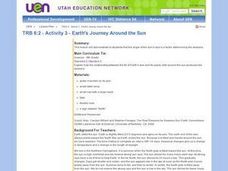Curated OER
Kids Conserve? Water Preserved
Students study conservation and how cities obtain their water. In this water instructional activity students view a PowerPoint presentation and draw a picture of the water cycle.
Curated OER
Meet Geodesy-The Science Behind GPS
Students discover how a datum of reference points are used to to describe a location. In this Earth Science lesson, students will simulate how a GPS accurately determines the location of reference points within a datum.
Curated OER
A Delicate Balance
Students complete an activity to help them understand the Earth's delicate balance. In this Earth lesson, students will draw and discuss the ways the Earth's atmosphere can be harmed. Students will then participate in a relay race that...
PHET
Measuring the Interplanetary Magnetic Field
Scientists need to figure out how to measure interplanetary magnetic fields, but the magnetic field of the spacecraft is interfering with their readings. Scholars attempt to solve the problem that has perplexed NASA scientists for years.
National Wildlife Federation
I’ve Got the POWER! Solar Energy Potential at Your School
Should every school have solar panels? The 19th lesson in a series of 21 has scholars research the feasibility of using solar panels at their school. They begin by gathering data on the solar energy in the area before estimating the...
Captain Planet Foundation
Shape Shifters in the Math Garden
Combines mathematical measurement with gardening skills. Third graders hunt for worms in the garden and try to find the longest one. They also measure and weigh vegetables that they harvest from the garden, measure rainfall amounts, and...
National Wildlife Federation
When It Rains It Pours More Drought and More Heavy Rainfall
Which is worse — drought or flooding? Neither is helpful to the environment, and both are increasing due to climate change. The 16th instructional activity in a series of 21 covers the average precipitation trends for two different...
Curated OER
How Big Are Earth, Sun, and Moon?
Third graders draw what they believe is in space on a dry erase board. In groups, they are given a beaker half filled with water and they add a teaspoon of oil, observing the different layers that form. To end the lesson, they identify...
Curated OER
The Starry Night Time and Day Time
Second graders complete a unit of lessons on the solar system. They complete various art projects inspired by Van Gogh's 'Starry Night,' create a moon phases book, create a moon phase wind chime, develop a timeline of space exploration,...
Curated OER
Make Your Own Trashasaurus Rex Sculpture
Students explore environmental awareness through reusing materials. In this environmental awareness lesson, students use trash to create a "trashasaurus," a large dinosaur sculpture made from waste. Detailed structure and papier-mâché...
Curated OER
Recycling Pals Coloring Page
In this recycling coloring worksheet, students color the six recycling characters pictured. Students then follow the 6 sets of instructions that challenge them to draw recycling pictures of their own.
Curated OER
Water Resources and the Role of the Independent Sector
Students identify the need to maintain and protect our natural resources. In this natural resource lesson plan, students study pictures of the effects of pollution on animals and water. Students brainstorm a list of ways water is an...
Curated OER
Save a Drop for Me
Learners discuss the meaning of philanthropy and how it applies to people caring about the water supply. In this water conservation instructional activity, students explore possible water conservation activities and select a project....
Curated OER
DAY AND NIGHT
Students use a lamp as the sun and his/her body as the earth. They rotate in different directions to explain how the earth moves around the sun. Using specific questions in their discussion, students discover the reasons for day and night.
Curated OER
Modeling Day and Night
Students complete a science experiment to study the role of night and day on sleep patterns. In this sleep patterns lesson, students brainstorm about night and day and the causes for the rotations on Earth. Students work in groups to...
Curated OER
Day and Night
Learners discuss why day and night occur after visualizing a teacher-led demonstration.
Curated OER
Understanding the Layers of the Earth
Fourth graders explore the three layers of the Earth describing the composition, thickness, and temperature of each layer. Layers are compared and contrasted and data unearthed placed into graphic organizers.
Curated OER
The Sun, Earth's Angles, and the Seasons
Students determine if the angle of light bombardment is a factor in heat absorption. They correlate these findings to the tilt of the Earth and the seasons. Students fold a pice of black construction paper in half, lengthwise. They tape...
Curated OER
Sun too close? We'll just change Earth's orbit
Pupils study an article and discuss what would happen if the Earth's orbit changed. In this Earth's orbit instructional activity students answer a list of questions and complete an activity.
Curated OER
Day 4: Plate Tectonics II
Learners explore the theory of plate tectonics. For this geology lesson, students conduct a simulation of the crust of the Earth floating on the mantle. Learners research plate tectonics and share their findings with the class. Students...
Curated OER
Day and Night
Students using experiments try to demonstrate how observations can be affected by the cycles of night and day.
Curated OER
Earth's Journey Around the Sun
Sixth graders examine how the angle of the sun's rays is a factor in determining the seasons. They watch a teacher demonstration of the concepts and write a paragraph demonstrating their understanding.
Curated OER
Rocks and Their Properties: Day 5
Students demonstrate their knowledge of rock formation processes in varied ways by sharing their cooperative research projects with the class. They generate well-framed questions in response to each presentation.
Curated OER
Rock and Their Properties: Days 2-4
Students engage in cooperative research projects in order to study about the properties of the three basic rock types and the processes that form them. They plan and develop their products.with the resources for conducting their...
Other popular searches
- Science Earth Day Activities
- Science Earth Day Lessons
- Science Earth Day
- Earth Day Science Projects
- Earth Day Science Lesson Plans
- Earth Science Earth Day


